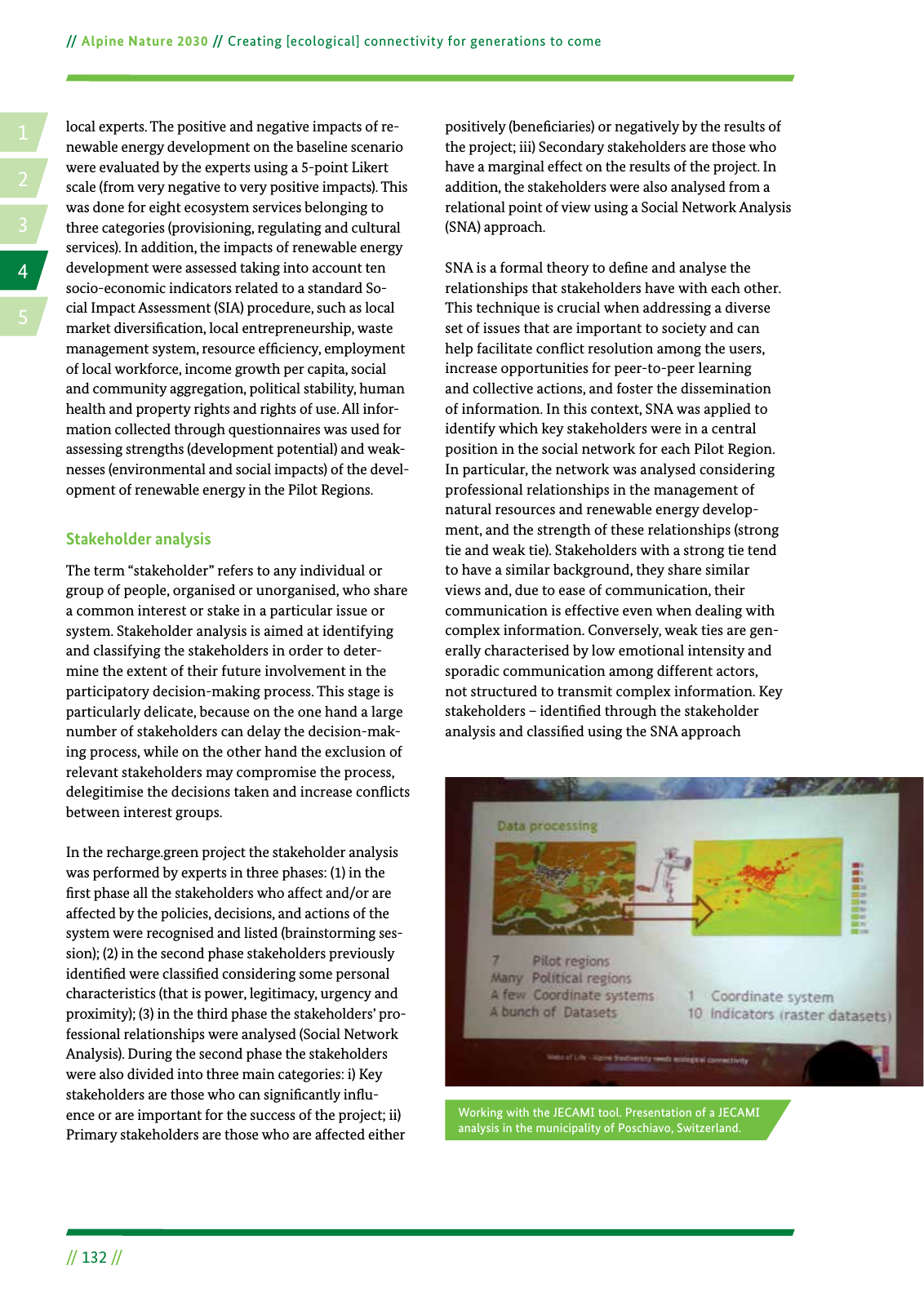14 2 5 3 Alpine Nature 2030 Creating ecological connectivity for generations to come 132 local experts The positive and negative impacts of re newable energy development on the baseline scenario were evaluated by the experts using a 5 point Likert scale from very negative to very positive impacts This was done for eight ecosystem services belonging to three categories provisioning regulating and cultural services In addition the impacts of renewable energy development were assessed taking into account ten socio economic indicators related to a standard So cial Impact Assessment SIA procedure such as local market diversi cation local entrepreneurship waste management system resource ef ciency employment of local workforce income growth per capita social and community aggregation political stability human health and property rights and rights of use All infor mation collected through questionnaires was used for assessing strengths development potential and weak nesses environmental and social impacts of the devel opment of renewable energy in the Pilot Regions Stakeholder analysis The term stakeholder refers to any individual or group of people organised or unorganised who share a common interest or stake in a particular issue or system Stakeholder analysis is aimed at identifying and classifying the stakeholders in order to deter mine the extent of their future involvement in the participatory decision making process This stage is particularly delicate because on the one hand a large number of stakeholders can delay the decision mak ing process while on the other hand the exclusion of relevant stakeholders may compromise the process delegitimise the decisions taken and increase con icts between interest groups In the recharge green project the stakeholder analysis was performed by experts in three phases 1 in the rst phase all the stakeholders who affect and or are affected by the policies decisions and actions of the system were recognised and listed brainstorming ses sion 2 in the second phase stakeholders previously identi ed were classi ed considering some personal characteristics that is power legitimacy urgency and proximity 3 in the third phase the stakeholders pro fessional relationships were analysed Social Network Analysis During the second phase the stakeholders were also divided into three main categories i Key stakeholders are those who can signi cantly in u ence or are important for the success of the project ii Primary stakeholders are those who are affected either positively bene ciaries or negatively by the results of the project iii Secondary stakeholders are those who have a marginal effect on the results of the project In addition the stakeholders were also analysed from a relational point of view using a Social Network Analysis SNA approach SNA is a formal theory to de ne and analyse the relationships that stakeholders have with each other This technique is crucial when addressing a diverse set of issues that are important to society and can help facilitate con ict resolution among the users increase opportunities for peer to peer learning and collective actions and foster the dissemination of information In this context SNA was applied to identify which key stakeholders were in a central position in the social network for each Pilot Region In particular the network was analysed considering professional relationships in the management of natural resources and renewable energy develop ment and the strength of these relationships strong tie and weak tie Stakeholders with a strong tie tend to have a similar background they share similar views and due to ease of communication their communication is effective even when dealing with complex information Conversely weak ties are gen erally characterised by low emotional intensity and sporadic communication among different actors not structured to transmit complex information Key stakeholders identi ed through the stakeholder analysis and classi ed using the SNA approach Working with the JECAMI tool Presentation of a JECAMI analysis in the municipality of Poschiavo Switzerland

Hinweis: Dies ist eine maschinenlesbare No-Flash Ansicht.
Klicken Sie hier um zur Online-Version zu gelangen.
Klicken Sie hier um zur Online-Version zu gelangen.